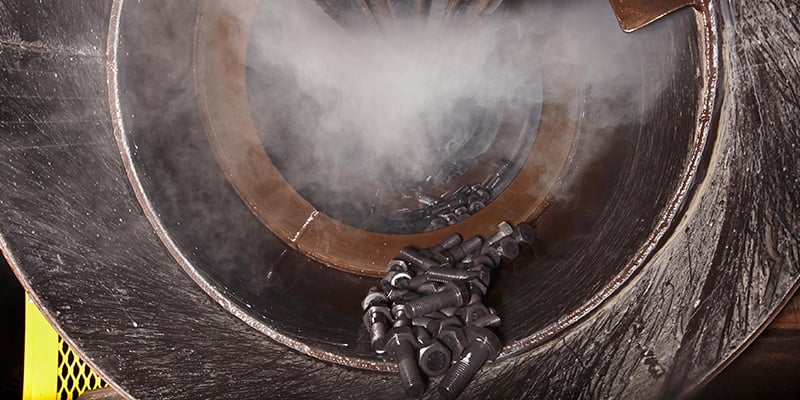Scale —the dark brown- or black-colored flaky material often observed on the surface of a part when exposed to high heat— is more than just unsightly.
Often, parts require additional machining after they’re heat treated, and if heat treat scale isn’t removed, it can flake off during machining. That can wear out or damage tools and increase the risk of surface defects on the finished part.
Heat treat scale can be removed or prevented, but manufacturers and heat treaters face some tradeoffs when determining which makes the most sense.
What causes heat treat scale?
Scale is an iron-rich film that can form on a part once it reaches high temperatures in heat treatment or manufacturing settings where the atmosphere is not controlled.
There’s no fixed temperature associated with scale formation because it’s very dependent on the elements making up a part. For instance, “cleaner” steels with low carbon content and low or no alloys scale more easily and at lower temperatures.
High-carbon, high-alloy steels are more resistant to scale, and much higher temperatures are required before it would form.
Manufacturers and heat treaters each have methods at their disposal to deal with scale problems, but tradeoffs exist that depend a great deal on part makeup, specified heat treatment and what happens next with a given part.
Heat treat scale removal
Manufacturers and heat treaters each have their preferred scale removal methods. Common methods include “pickling” a part in aqueous acid solution, washing it in scale removal chemicals, electronic removal (via a process that’s essentially the opposite of electroplating) and mechanical removal.
Heat treaters typically prefer mechanical removal via blasting. Chemical removal requires the use of dangerous materials that would force compliance with added environmental regulations.
One of the tradeoffs in the scale removal vs. prevention debate is what will happen next to a part. For example, forgings often are machined after through hardening. It’s cheaper to heat treat in a non-atmosphere controlled furnace where scale will form and then remove the scale because further machining will occur. That’s opposed to treating in a controlled-atmosphere furnace where scale won’t form but which is more expensive.
Similarly, heat treat scale removal can be recommended for larger batches because it’s cheaper to heat treat in larger, non-atmosphere controlled furnaces and then remove scale as opposed to running multiple smaller batches through atmosphere-controlled equipment.
Heat treat scale prevention
There are some instances, however, when heat treat scale prevention is recommended over removal.
For example, tool steel and stainless steel parts are often best treated in vacuum furnaces that remove atmosphere from the chamber. With no atmosphere to react to, scale won’t form. The parts do not experience decarburization and do not form cases, such as in case hardening.
A manufacturer could request that parts be treated in vacuum furnaces which suck atmosphere out of the chamber or in integral quench furnaces designed to eliminate oxygen in the atmosphere to prevent scale formation, but those processes are more expensive. It can sometimes be cheaper to treat in furnaces without atmospheric control and then remove the scale afterward. Raw castings and forges, for example, are often allowed to scale during normalizing because they’ll be heavily machined after treatment anyway.
Plan ahead
Remember that scale formation represents an actual loss of material on a part. If you’re concerned that your specs don’t account for this loss, speak with your engineers about designing with scale removal in mind and whether it’s feasible to design with more scale-resistant materials. When in doubt, contact us to talk it through in more detail.
Heat treat scale is a fact of life in the industry. Managing it comes down to knowing what your parts are made of, knowing which heat treatments are most appropriate and making an economic decision. An outsourced heat treating partner like Paulo can help you make that decision. Download the guide below for more about how an outsourced partner can help you manage risk in heat treatment.



